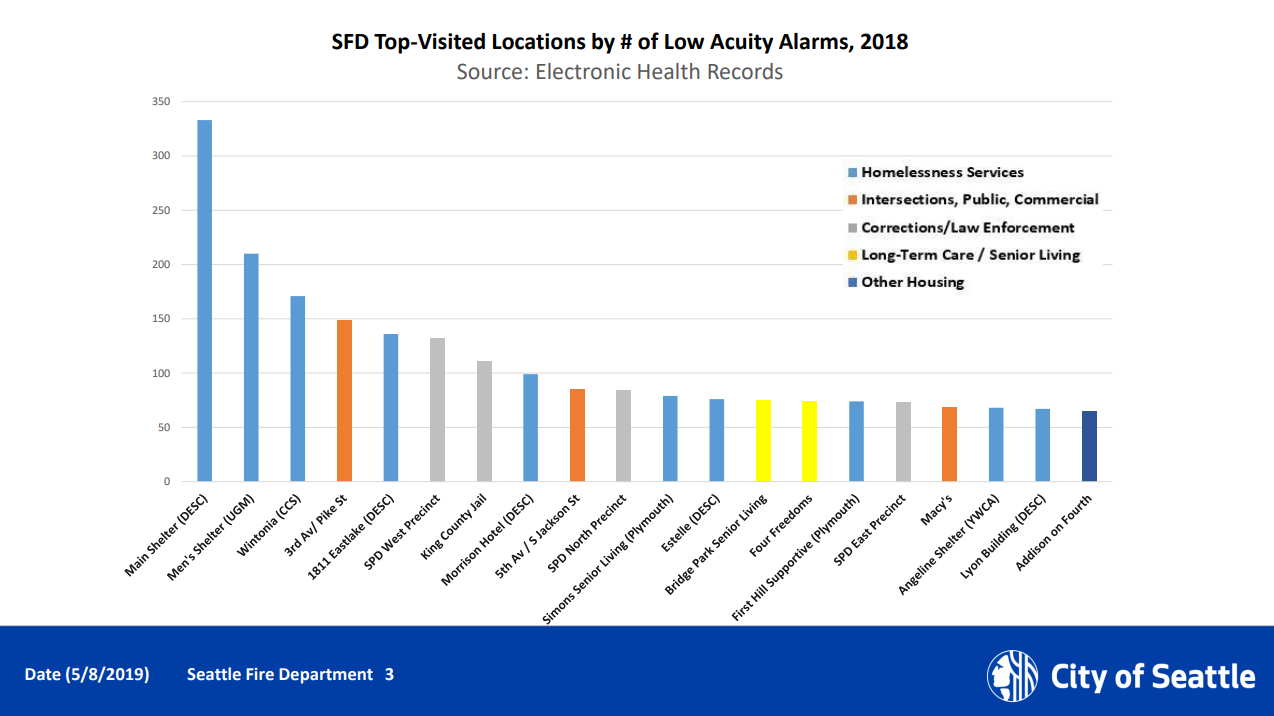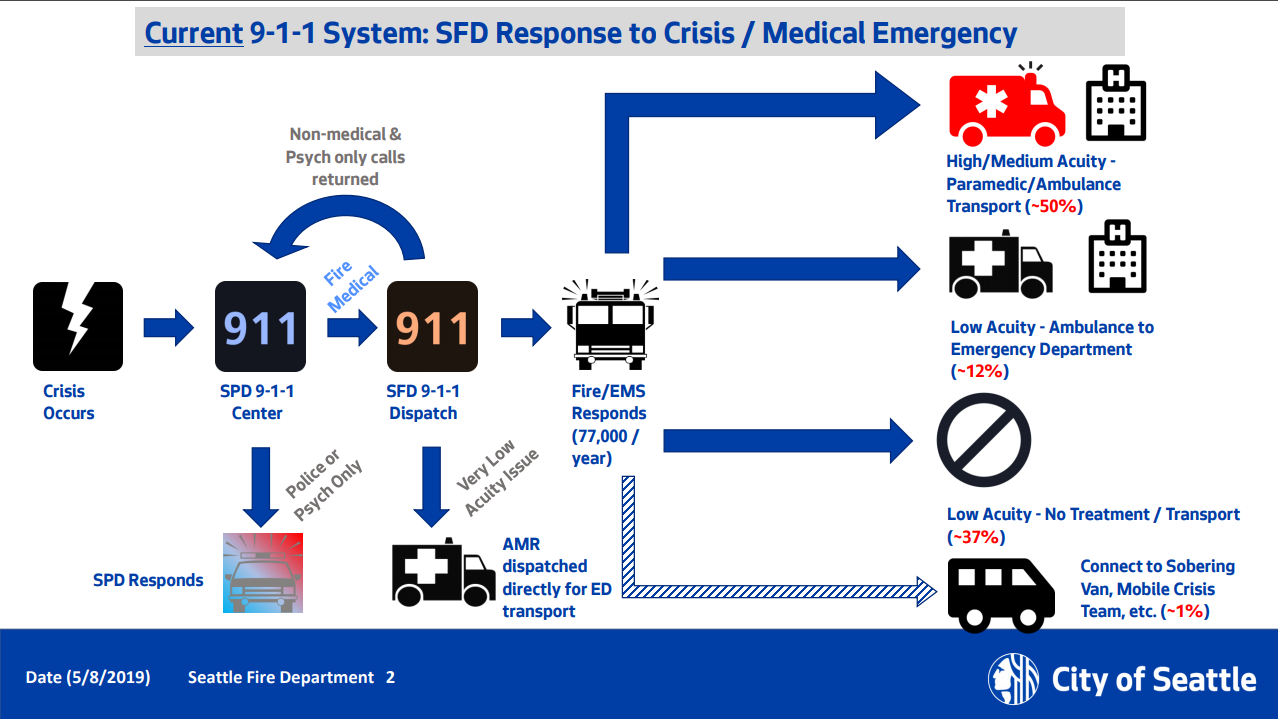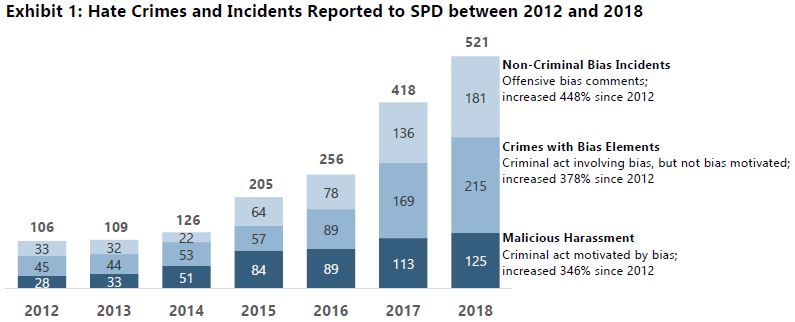Firefighters Propose Health Help Changes for Homeless People; Addressing Hate Crimes in Seattle; Count Us In and HSD Updates on Homelessness Intervention System
Firefighters Propose Health Help Changes for Homeless People
This week, in Councilmember González’s committee, the Council received a report and an update from the Seattle Fire Department on the Mobile Integrated Health Response Team pilot program. Under Councilmember Bagshaw’s leadership, the Council passed funding during the last budget to provide services to individuals, primarily homeless people, who are currently sent to the Emergency Room because they are in need of care, although they help they need doesn’t actually require a trip to the Emergency Room. This is a huge waste of resources.
These are called “low acuity calls” which are usually “chronic or acute minor medical issues where the patient has no access to appropriate care; lifting a resident back into a wheelchair or bed after a fall; mental health crisis; social service needs; and issues related to drug or alcohol use.” Fifty percent of the time, 911 calls to SFD result in a. no action, b. a non-emergency ambulance transport to an Emergency Department. Or c. connection to a sobering van or mental health crisis team. Only half the time do the 911 calls to SFD actually result in an ambulance transport. The Seattle Fire Department currently responds to 911 calls to SFD calls with a fully staffed engine, ladder, or aid car.
Many of the locations that SFD fire fighters are responding to are organizations that have connections or contracts with other City and County departments and often have medical professionals onsite during the day, but there is no one on staff in the evenings when the low acuity calls are more numerous. As more individuals are referred to Permanent Supportive Housing (PSH), people who most need services and housing are being better prioritized; however, yet funding for these services has not kept pace with their needs. This means that while the Seattle Fire Department provides training on low acuity call diversion for the staff of PSH providers, the high rate of staff turnover due, in part to low wages, reduces the long-term effectiveness of this training. Beginning this month, the Seattle Fire Department, IAFF Local 27 (the fire fighters’ union), and other partner City and County organizations will bring this pilot program online in order to lessen the impact of non-emergency requests for service on SFD operations units. The Council will continue to track this pilot and evaluate its effectiveness and determine if it can be expanded based on its success.
Addressing Hate Crimes in Seattle
The City Auditor has released a report completed at my request, Review of Hate Crime Prevention, Response and Reporting in Seattle: Phase 2 Report.
The report finds significant increases, almost 400%, in reported hate crimes and incidents in Seattle, from 106 in 2012 to 521 in 2018; reports of hate crimes doubled from 2014 to 2016, and again from 2016 to 2018. The protected classes of race, LGBTQ, religion, and ethnicity had the highest number of reports. The largest increase in reported hate crimes and incidents, with a 427% increase in reporting of hate crimes and incidents motivated by race.
The report notes that a rise in reported hate crimes doesn’t necessarily mean more are occurring. It can also mean that law enforcement is prioritizing these crimes (in recent years SPD has hired a bias crimes detective, and posted data on hate crimes). However, the FBI has found that hate crimes have risen across the nation as well during the last four years, so it’s clear this is a trend we must respond to.
The City Auditor will present the report in the Civil Rights, Utilities, Economic Development and Arts Committee meeting on May 14th where I will propose updated legislation to allow the City Attorney to more easily prosecute misdemeanor hate crimes.
Current city law limits prosecutions to those hate crimes that a motivated by someone’s age, parental status, political ideology, marital status, and homelessness.
The proposed legislation would allow the City Attorney to also prosecute misdemeanor hate crimes based on race, color, religion, ancestry, national origin, gender, sexual orientation, gender expression or identity, mental disability, physical disability, sensory disability.
The legislation also updates descriptions of disability and gender expression or identity to conform with legislation recently passed by the state legislature.
The report also includes recommendations for tracking hate crimes, and geographic analysis of hate crimes. The geographic analysis found hate crimes most frequently occur in 1) high traffic areas on transit routes (e.g. Rainier Avenue in SE Seattle); 2) areas of dense demographic diversity, and 3) borders of racially diverse neighborhoods. 23% of hate crimes occurred on a bus or at a bus stop; Downtown had more anti-race and ethnicity crimes, while Capitol Hill experienced more anti-LGBTQ crimes.
The City Attorney prosecuted 23 malicious harassment cases in the six years from 2012 to 2017. This is evidence of the limitations of existing law, not in the interest of the City Attorney in prosecuting these crimes.
King County is able to prosecute a wider variety of bias categories. The audit examined the 118 cases prosecuted by the county from 2012 to 2017. The audit found that 85% of perpetrators of hate crimes prosecuted in King County were male; 77% were white, and 19% black.
The proposed legislation includes a requirement for an annual report from the City Attorney on the demographics of the defendants and protected class of the victims. It’s important to track how the legislation is used to address hate crimes, while keeping in mind valid concerns about existing disparities in prosecution, where black men are more likely to be prosecuted for violations such as assault.
Thank you to City Attorney Holmes for his work on this proposal, and to the Seattle Police Department for their increased attention to hate crimes in Seattle.
Here’s a link to the 2017 Phase 1 report; that report focused on the practices and processes the Seattle Police Department (SPD) follows to identify, respond to, and prevent hate crimes. The press release I sent out in response to the new Phase 2 report is linked here.
I believe that with the divisive rhetoric coming daily from the current administration, a rise in white nationalism, and the cowardly violence of domestic terrorism, it’s not enough to know that these crimes are being committed. Now that we have a better picture of the trends, it’s incumbent on leaders and allies to take action to prevent, respond, investigate and prosecute hate crimes.
Count Us In and HSD Updates on Homelessness Intervention System
Last Friday, All Home, the organization that coordinates, conducts, and reports the homeless persons point-in-time (PIT) count, put out an advanced news release previewing the “Count Us In” report. This report Is a sort of census of homeless people. Participation in PIT Counts is required by jurisdictions that receive federal dollars for homelessness like McKinney-Vento Homeless Assistance Grants and distinguishes homelessness by two groups; people living unsheltered outside or in places not meant for human habitation (like cars), and people living in emergency shelter or transitional housing.
Count Us In is a snapshot in time and is generally regarded as an undercount. But it is also an important foundation to assess how our region is doing in addressing homelessness. The release provided some helpful data to reflect the concerted efforts of the City and County in moving people experiencing homelessness to housing: throughout all of King County, there was an 8% decrease in the overall population of people experiencing homelessness (from 12, 112 from the 2018 PIT count to 11,199 from the 2019 count) and specifically a 17% decrease throughout King County of people living unsheltered. All Home also records additional details like a. demographics, b. a city by city count of the numbers of homeless people (we currently only have the countywide number), c. people’s last physical address was before they became homeless, and d. the primary event that led to their homelessness. We don’t have this detail yet. All Home has a new dashboard tool that will provide a monthly snapshot of people who have accessed services from a program that participates in the Seattle-King County Continuum of Care’s Homeless Management Information System (HMIS). People accessing services have steadily increased through the last quarter of the year in 2018. Tracking our homelessness intervention system successes depends on our ability to capture data on how we connect people to our tiny house villages, enhanced shelters, or rapid rehousing services. Earlier this month, the Human Services Department (HSD), which coordinates our City’s homelessness intervention system, also released data that reflected positive results.
Prevention programs so people maintain housing and don’t become homeless:
1302 households served with 89% success
Basic Shelter:
5121 households in 668 shelter beds (down from 964 in 2017 because of conversion of basic shelter to enhanced shelter) served with 4% moving to permanent housing (same as 2017)
Enhanced Shelter (provide showers, laundry, safe cooking facilities, storage for belongings, and accommodate couples and pets):
6554 households served in 1411 beds (up from 749 in 2017) with 21% moving to permanent housing (up from 13% in 2017)
Tiny House Villages:
658 households served in 328 units (up 255 from in 2017) with 33% moving to permanent housing (up from 23% in 2017)
Transitional Housing:
905 households served in 717 units (down from 833 units in 2017, because we are evolving the transitional housing model to permanent support housing) with 66% moving to permanent housing (up from 55% in 2017)
Diversion (funds that help people homeless people bypass shelter):
1401 households served with 72% moving to permanent housing (up from 67% in 2017)
Rapid Rehousing:
1179 households served with 78% moving to permanent housing (up from 72% in 2017)
Permanent Supportive Housing:
2056 households served in 1922 beds (up from 1107 in 2017) with 93% staying in their housing (up from 92% in 2017)
In addition, because we are funding more agencies that provide culturally-relevant services, exits to permanent housing of American Indian/Alaska Native household increased by 87% and that of Black/African American household increased by 27%. Data reflecting the success of our enhanced shelters is particularly important to me. The City Auditor recommends increasing enhanced shelter because “lack of enhanced shelters adversely affects the Navigation Team’s ability to make alternate living arrangement referrals.” When having to move because of an encampment removal, people living outside accept enhanced shelter at a much higher rate than basic shelter.
Last year, the City Auditor, at my request, reviewed the Navigation Team’s outcomes connecting people living unsheltered to alternatives. The objective is to provide accountability for our investments in the Navigation Team and to assess the fidelity of our encampment removal process in 1) mitigating health and safety risks for people living unsheltered and their surrounding communities, 2) connecting people with services and housing, and 3) using a person-centered, trauma-informed approach. I want to be sure that removing people living unsheltered is focused in areas that are of the most imminent health and safety risk, and that we are offering alternatives to where people can move. In the 2018 budget I sponsored a proviso on Navigation Team funding based on submissions of quarterly reports to evaluate their performance meeting the Navigation Team goals. You can watch the most recent of these audits from Civil Rights, Economic Development and Arts Committee here in February here. I intend to share updates from this audit report in future posts.
Posted: May 11th, 2019 under Councilmember Herbold, Homelessness, Human Services, LGBTQ, Office of Police Accountability, Police Department, Public Health, Seattle Fire Department
Tags: All Home, Arts Committee, Civil Rights, Count Us In, Economic Development, Hate Crime, HMIS, homeless, HSD, Mobile Integrated Health Response Team pilot program, Navigation Team, Permanent Supportive Housing (PSH), Seattle Fire Department, SFD, shelter, Tiny House Villages, Transitional Housing, Utilities




